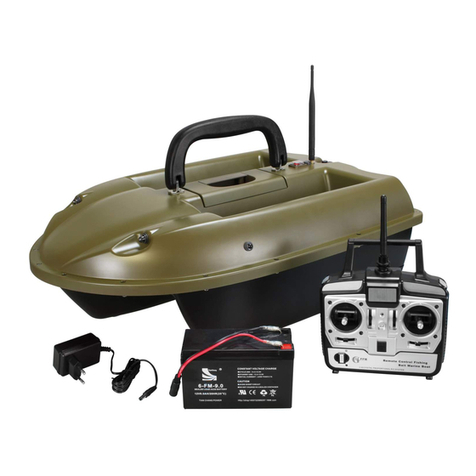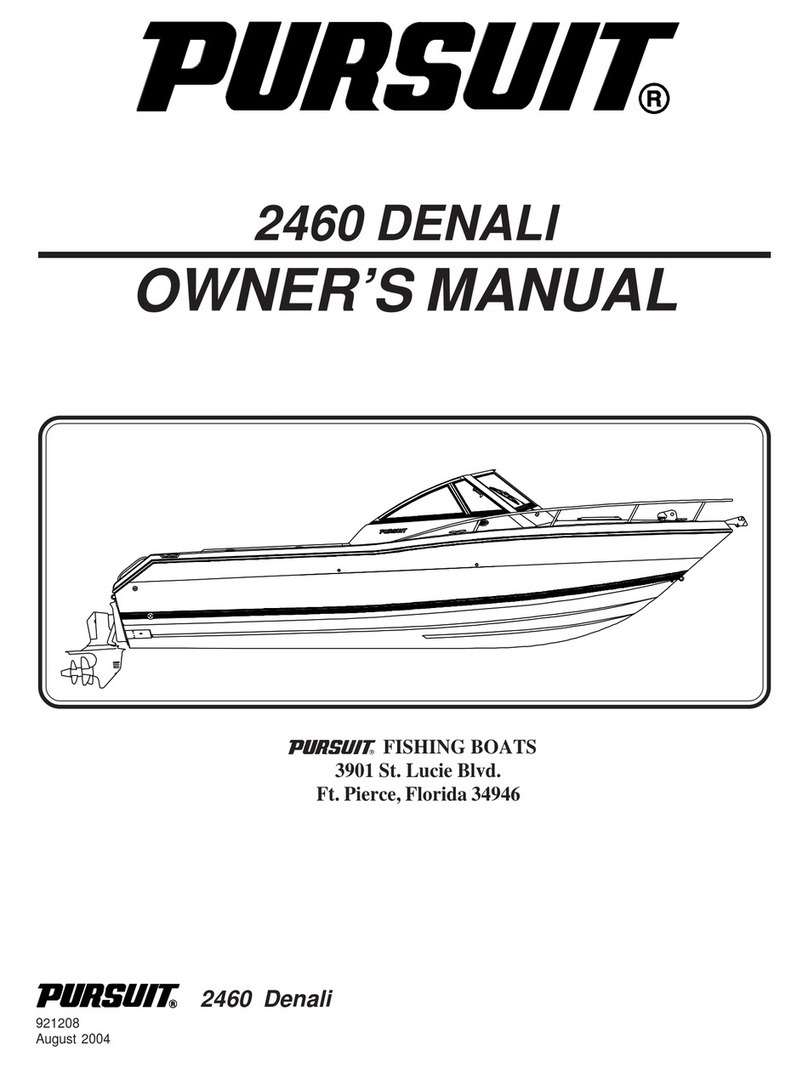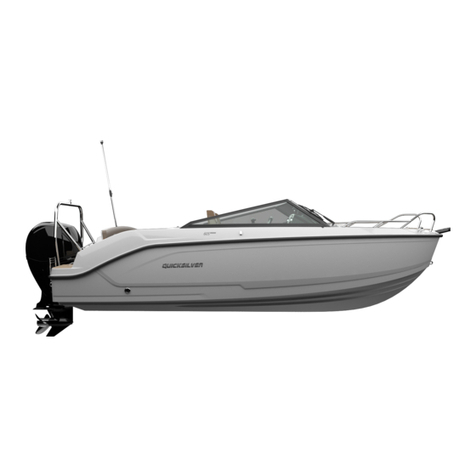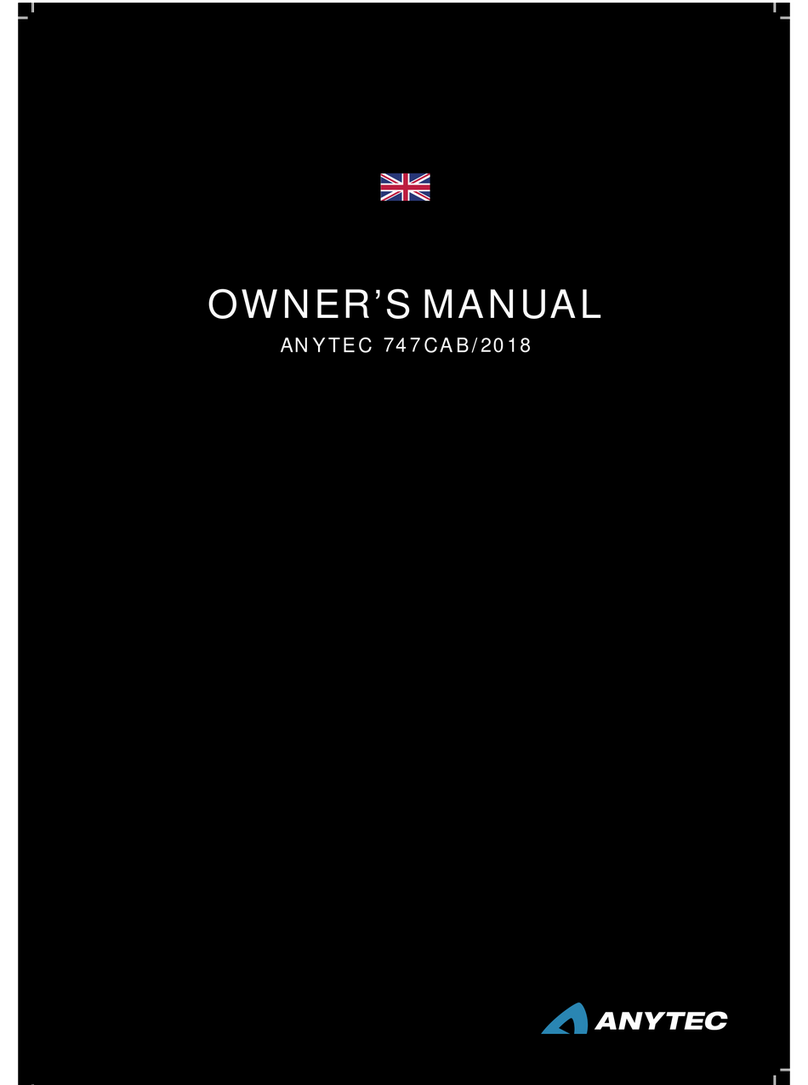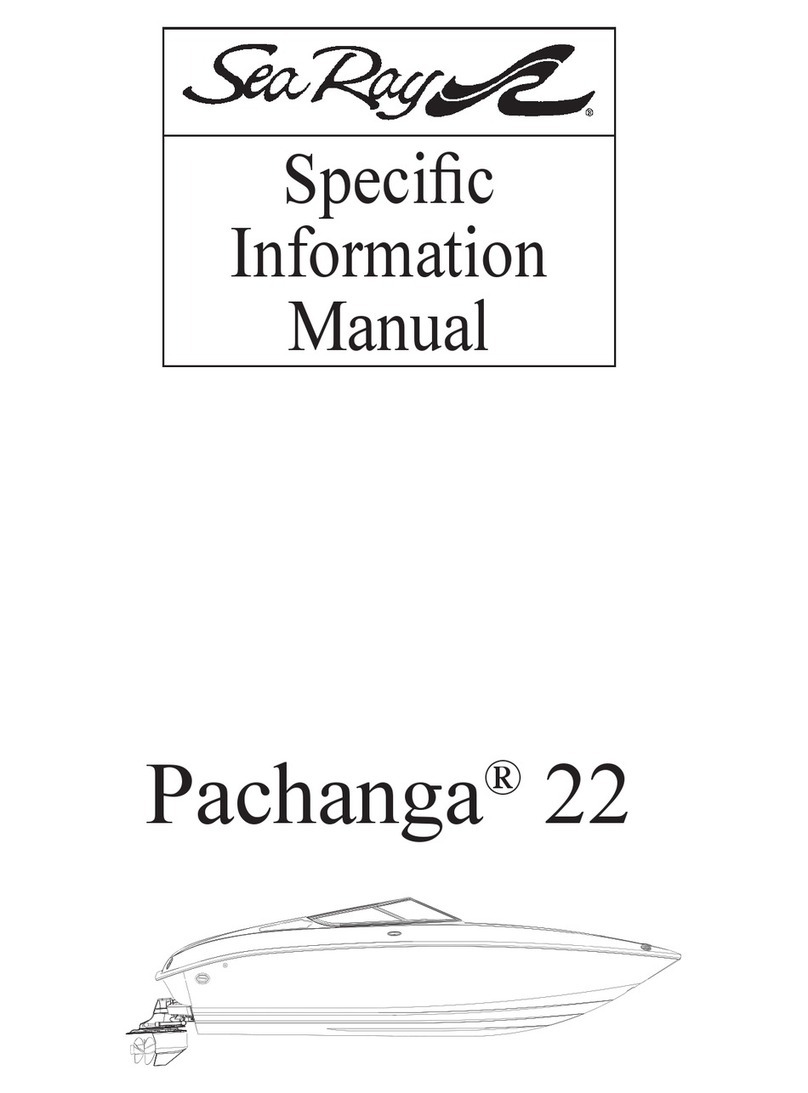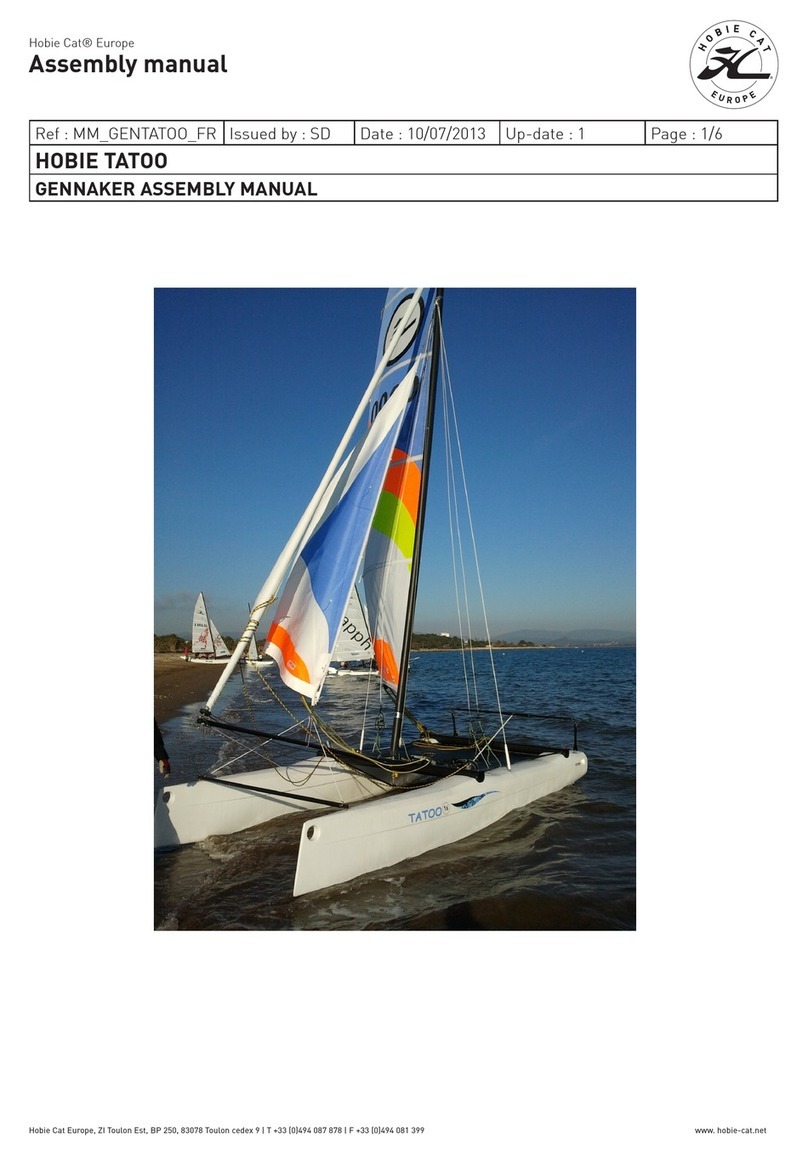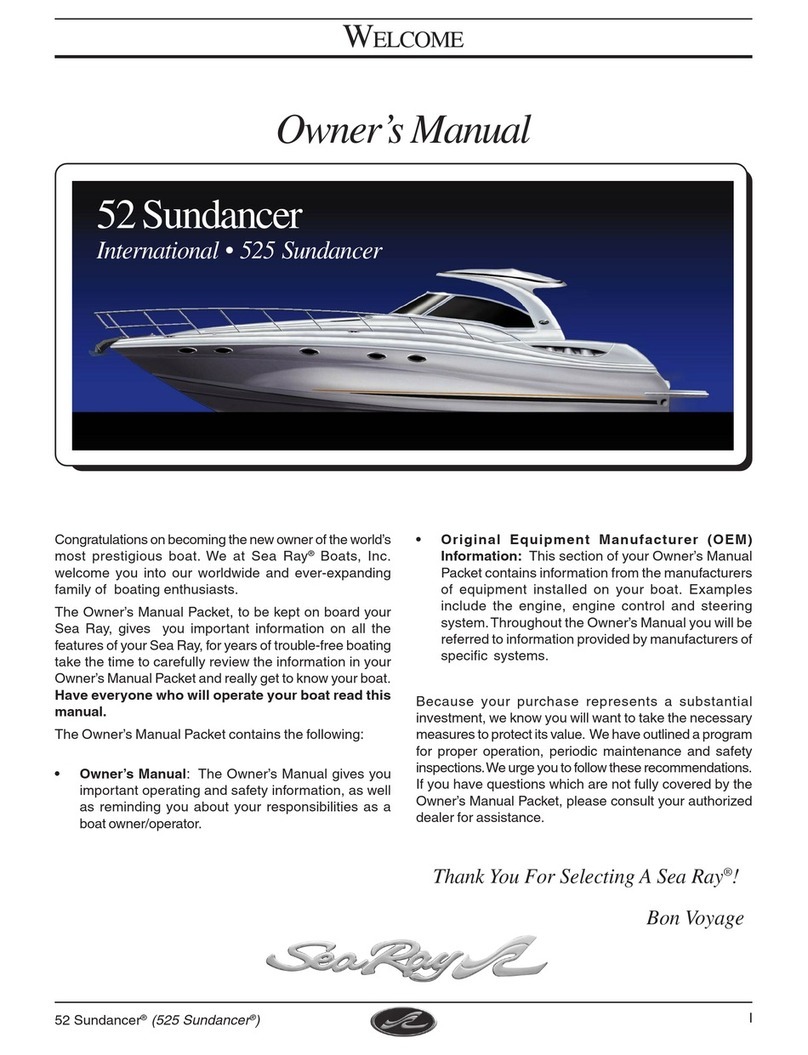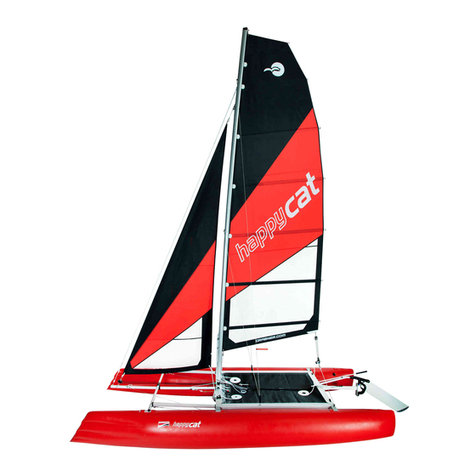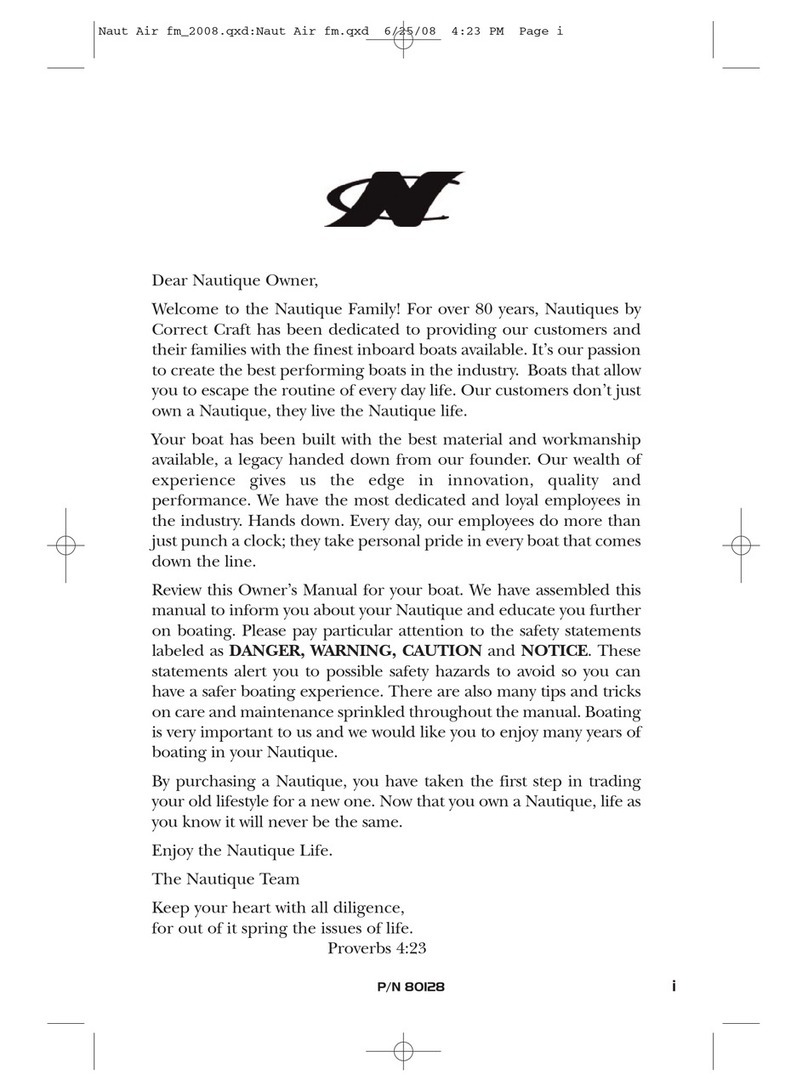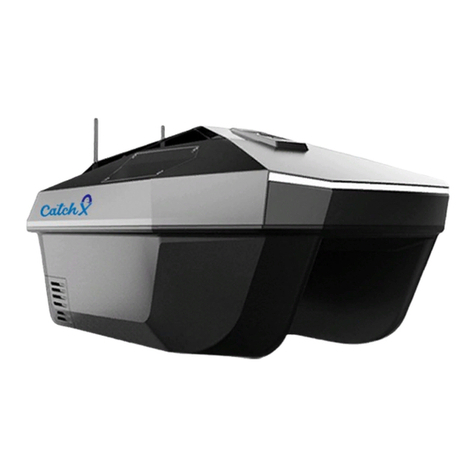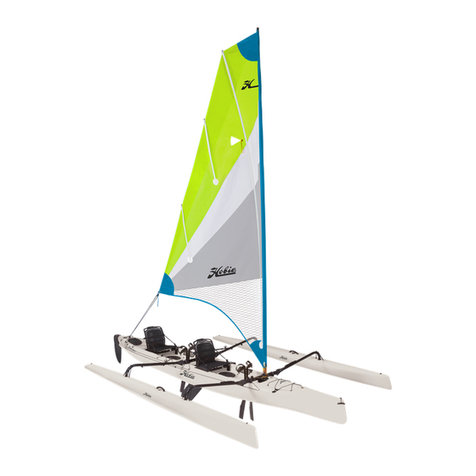Robertson and caine LePard 46 User manual

OWNER’S MANUAL
THREE CABIN VERSION (110V)
ZA-RAC A1010 J607
ROBERTSON AND CAINE (PTY) LTD
CAPE TOWN SOUTH AFRICA

OWNER’S MANUAL
A1010 3 Cabin Segue 110V Original Dated Sept 2006.doc Page 2 of 59
INDEX
1. Introduction
2. Issue sheet
3. Copy of Builder’s Plate
4. List of ISO Standards Applicable
5. Certificate of Conformity
6. Warning Symbols on Board
7. Boating Safety
7.1 Prevention of Capsize
7.2 Anchoring, Mooring & Towing
7.3 Visibility from Helm Station
7.4 Davit Operation
7.5 Carbon Monoxide
8. Load Calculations
8.1 Specifications.
9. Ecological / Operational Aspects
9.1 Environment Protection
9.2 Maintenance
9.3 Operational
9.4 Flooding
9.5 Fire
10. Fire Fighting
11. Life raft Stowage
12. Gas System Operation
13. Bilge Pump Operation
14. Toilet Operation

OWNER’S MANUAL
A1010 3 Cabin Segue 110V Original Dated Sept 2006.doc Page 3 of 59
INDEX (Cont.)
15. Fresh Water System Operation.
16. Steering
17. Engines
17.1 Engine Ventilation
17.2 Engine Fuel
17.3 Engine Exhaust
17.4 Propellers
17.5 Genset
18. Electrical System DC
18.1 Battery operation
18.2 Windlass operation.
19. Electrical System AC
19.1 Shore Power Connection
20. Fridge / Freezer Operation
21. Air-Conditioning
22. Lay up and Winterization.
23. Hull Lifting, Transport and Shipping.
24. Cleaning and Maintenance
25. Warranties
26. OEM Contact Details
27. Index of drawings

OWNER’S MANUAL
A1010 3 Cabin Segue 110V Original Dated Sept 2006.doc Page 4 of 59
1. INTRODUCTION
This owner’s manual introduces you to the special features of your yacht. Read this
owner’s manual carefully before you go to sea and refer to it frequently during your
ownership. This manual and the equipment manuals provided will help you to
operate and maintain the yacht safely. Please keep the manuals safely in a place
that is easily accessible.
ABOUT YOUR OWNER’S MANUAL
This owner’s manual includes descriptions of the yachts various systems and general
information on the operation and maintenance of the yacht. Please note that the
information supplied in this manual only summarizes the more detailed information in
the equipment manuals. Robertson & Caine (Pty) Ltd retain the right to make
changes in products manufactured and or used by us at any time without prior notice
and without occurring any further obligation to make the same or similar changes on
products previously manufactured or sold. Constant efforts are made to improve the
Quality and performance of our products so some details included in this manual may
differ slightly from your vessel. All Drawings included in this manual are schematic
representations only. All dimensions and positions indicated must be verified on the
actual vessel. If you have any questions please consult your sales agent or broker
EQUIPMENT MANUALS
Certain equipment and components purchased from the original equipment
manufacturer (OEM) have been installed in your yacht. These include the engines,
batteries, hatches, electronic equipment, stove, microwave, etc. Where applicable
the operation and maintenance manuals provided by the OEM’s have been included
in the Owners manual pack. Most OEM supplied equipment has its own limited
warranties and the warranty registration cards are also provided with your Owners
manual pack.
MAKE SURE THAT THESE MANUALS ARE TRANSFERRED TO SUBSEQUENT OWNERS.
While all the information it contains is important, items of special importance to you
are shown in CAPITALS.
If your experience in cruising or yacht ownership is limited you are strongly advised
to take instruction from a professional, registered institution.
This owner’s manual is written in conformance with the
European Recreation Craft Directive 94/25/EC as amended by Directive 2003/44/EC
and the notified body is the
European Certification Bureau Netherlands B.V.
Address: Juliana weg 224A 1131 NW Volendam
Telephone: + 31 (0) 299 323 123 or 320 477
Fax: + 31 (0) 299 323 023
Internet: www.ecb.nl

OWNER’S MANUAL
A1010 3 Cabin Segue 110V Original Dated Sept 2006.doc Page 5 of 59
2. ISSUE SHEET
CRAFT IDENTIFICATION NUMBER: ZA-RAC A1010 J607
THIS DOCUMENT IS ISSUED BY ROBERTSON AND CAINE (PTY) LTD OF CAPE
TOWN, SOUTH AFRICA.
DATE: 09 October 2006 QUALITY ASSURANCE MANAGER
RECEIVED:
DATE FIRST OWNER
SUBSEQUENT ISSUES ON CHANGE OF OWNERSHIP
SUPPLIED BY RECEIVED BY
2
SELLER BUYER
DATE DATE
3
SELLER BUYER
DATE DATE

OWNER’S MANUAL
A1010 3 Cabin Segue 110V Original Dated Sept 2006.doc Page 6 of 59
3. COPY OF BUILDER’S PLATE
The maximum load of 4180kg specified on the Builder’s Plate excludes the
weight of fresh water and fuel onboard. Fresh water and fuel have a
combined weight of 1840kg.

OWNER’S MANUAL
A1010 3 Cabin Segue 110V Original Dated Sept 2006.doc Page 7 of 59
4. List of ISO Standards Applicable
ISO 7840 Small Craft – Fire Resistant Fuel Hoses
ISO 8099-
1/2/3
Small Craft - Waste water retention and treatment systems Parts
1,2,3
EN/ISO 8665 Small craft - Marine propulsion engines and systems –
Power measurements and declarations
ISO 8666 Small craft - Principal data
EN 28846 Small craft - Electrical devices -Protection against ignition of
surrounding flammable gases
EN 28848 Small craft - Remote steering systems
EN 28849 Small craft - Electrically operated bilge-pumps
ISO 9093 – 1 Small craft - Seacocks and through-hull fittings metallic
ISO 9093-2 Small craft - Seacocks and through-hull fittings non metallic
ISO 9094-1 Small craft - Fire Protection
EN/ISO 9097 Small craft - Electric fans
EN/ISO 10087 Hull identification - Coding system
ISO 10088 Small craft - Permanently installed fuel systems and Fixed fuel
tanks
ISO 10133 Small craft - Electrical systems - Extra-low-voltage D.C.
Installations
ISO 10239 Small craft - Liquefied petroleum gas (LPG) systems
EN/ISO 10240 Owner’s manual
ISO 11591 Small craft engine driven field of vision from helm position
ISO 11812 Small craft - Cockpit and cockpit drainage
ISO 12215-1 Small craft – Hull construction – Scantlings – Part 1: Materials
thermosetting resins, glass fibre reinforcement, reference
laminate
ISO 12215-4 Small craft – Hull construction – Scantlings – Part 4: Workshop
and construction
ISO 12216 Small craft – Windows, portlights, hatches, deadlights and doors
– Strength and tightness requirements
ISO 12217-2 Small craft – Stability and buoyancy – Methods of assessment
and categorisation – Part 2: Sailing boats
ISO 13297 Small craft - Electrical systems. Alternating current installations
ISO 14945 Small craft – Builder’s plate
ISO 14946 Small craft - Maximum load capacity
ISO 15083 Small craft - Bilge pumping systems
ISO 15084 Small craft - Anchoring, mooring and towing - Strong points
ISO 15085 Guard-rails, lifelines and handrails
ISO 16147 Small craft – Inboard Diesel Engines – engine mounted fuel &
electrical components.

OWNER’S MANUAL
A1010 3 Cabin Segue 110V Original Dated Sept 2006.doc Page 8 of 59
5. Certificate of Conformity
It is hereby certified that, to the best of our capacity, and as determined by our
Quality Control System, this yacht is built in accordance with the prescribed
Technical Construction details and in accordance with the ISO Standards listed in
Section 5 of this manual.
Rob Brennan
Quality Assurance Manager
For Robertson and Caine (Pty) Ltd
Date: 09 October 2006

OWNER’S MANUAL
A1010 3 Cabin Segue 110V Original Dated Sept 2006.doc Page 9 of 59
DECLARATION OF CONFORMITY
Recreational Craft • Directive 94/25/EC as amended by directive 2003/44/EC
MANUFACTURER’S NAME: Robertson and Caine International Yachts
ADDRESS: Beach Road and Railway Streets, Woodstock
POST CODE: 7915 CITY: Cape Town
COUNTRY: (code) ZA Print: South Africa
MODULE USED: (check) A Aa B+C X B+D B+F G H
IF THE DECLARATION IS MADE BY AN AUTHORISED REPRESENTATIVE
AUTHORISED REPRESENTATIVE ESTABLISHED IN EEA TERRITORY:
ADDRESS:
POST CODE: CITY:
COUNTRY: (code) Print:
IF INTERVENTION OF A NOTIFIED BODY
NAME: European Certification Bureau Nederland
IDENTIFICATION
NUMBER: 0614
ADDRESS: Julianaweg 224A
POST CODE: 1131 NW CITY: Volendam
COUNTRY: (code) NL Print: Holland
EC TYPE-EXAMINATION CERTIFICATE NUMBER (if issued): ,
DATE (day / month / year)
DESCRIPTION OF CRAFT
CRAFT IDENTIFICATION NUMBER: Z A - R A C A 1 0 1 0 J 6 0 7
BRAND NAME OF CRAFT: Leopard
TYPE OR NUMBER: : 46
DESIGN CATEGORY : A
TYPE OF CRAFT : Sailing Catamaran (01)
TYPE OF HULL* : Multihull (02)
DECK* : Fully Decked (01)
CONSTRUCTION MATERIAL* : GRP (02)
PROPULSION* : Diesel Engine (03)
TYPE OF ENGINE* : Volvo D2-55 (02)
MAXIMUM RECOMMENDED ENGINE POWER (kW) : 41kW @ 3000 RPM
HULL LENGTH AND BEAM : 14.13m / 7.57m
DRAUGHT : 1.25m Lightship
I declare at my own and sole responsibility that the craft mentioned above complies with all applicable essential
requirements in the way specified and is in conformity with the type for which the above mentioned EC type
examination certificate has been issued.
Name: R BRENNAN
Signature and
title: (Q.A MANAGER)
(identification of the person empowered to sign on behalf of the manufacturer
or his authorised representative)
(or an equivalent
marking)
Date (yr/mon/day): 2006-10-09

OWNER’S MANUAL
A1010 3 Cabin Segue 110V Original Dated Sept 2006.doc Page 10 of 59
Type of craft
Propulsion
01 sailboat 01 sails
02 inflatable 02 petrol engine
03 other (specify):
01
03 diesel engine
04 electrical motor
Type of hull: 05 oars
01 monohull 06 other (specify):
01 / 03
02 multihull
03 other (specify):
02
Type of engine:
01 outboard
Construction material: 02 inboard
01 aluminium, aluminium alloys 03 z or sterndrive
02 plastic, fibre reinforced plastic 04 other (specify):
02
03 steel, steel alloys
04 wood Deck
05 other (specify):
02
01 decked
02 partly decked
03 open
01
Essential requirements
(reference to relevant articles in
Annex 1 of the Directive)
Harmonised standards
used
ISO-standards used
Other normative
document used
See the technical file
General requirements (2)
Craft Identification Number – CIN (2.1) EN/ISO 10087
Builder’s Plate (2.2) ISO 14945
Protection from falling overboard and means of reboarding (2.3) ISO 15085
Visibility from the main steering position (2.4) ISO 11591
Owner’s manual (2.5) EN/ISO 10240
Integrity and stuctural requirements (3)
Structure (3.1) ISO 12215
Stability and freeboard (3.2) ISO 12217-1
Buoyancy and floatation (3.3) ISO 12217-2
Openings in hull, deck and superstructure (3.4) ISO 9093-1
Flooding (3.5) ISO 11812
Manufacturer’s maximum recommended load (3.6) ISO 14946
Liferaft stowage (3.7) RSG Guidelinds
Escape (3.8) ISO 9094
Anchoring, mooring and towing (3.9) ISO 15084
Handling characteristics (4) ISO 8665
Engines and engine spaces (5.1) ISO 4589
Inboard engine (5.1.1) ISO 9094-1
Ventilation (5.1.2) ISO 16147
Exposed parts (5.1.3) RSG Guidelines
Outboard engine starting (5.1.4) N/A
Fuel system (5.2)
General – fuel system (5.2.1) ISO 10088
Fuel tanks (5.2.2) ISO 10088
Electrical systems (5.3) ISO 13297/10133
Steering systems (5.4)
General – steering system (5.4.1) ISO 28848
Emergency arrangements (5.4.2) RSG Guidelines
Gas systems (5.5) ISO 10239
Fire protection (5.6)
General – fire protection (5.6.1) ISO 9094-1
Fire-fighting equipment (5.6.2) ISO 9094-1
Navigation lights (5.7) COLREGS
Discharge prevention (5.8) ISO 8099

OWNER’S MANUAL
A1010 3 Cabin Segue 110V Original Dated Sept 2006.doc Page 11 of 59
6. WARNING SYMBOLS ON BOARD
The following warning symbols will be found on board.
DURING SAILING OR AT ANCHOR IN ROUGH SEAS ENSURE THAT THE
COMPANIONWAY DOOR BARREL BOLT IS IN THE LOCKED POSITION WHEN
THE DOOR IS OPEN. SERIOUS INJURY COULD RESULT IF THIS IS NOT DONE
! WARNING

OWNER’S MANUAL
A1010 3 Cabin Segue 110V Original Dated Sept 2006.doc Page 12 of 59
! CAUTION
! WARNING
7. Boating Safety
The yacht owner or skipper is responsible for the safety of the passengers and crew,
as well as other boaters. As you read this manual and the original equipment
manufactures manuals provided, the following warning symbols will be found to alert
you to possible safety hazards.
Danger calls attention to an immediate hazard or unsafe condition that could result in
severe injury or even death.
Warning identifies hazards or conditions that could result in personal injury or
damage to equipment and machinery.
Caution indicates potential hazards or unsafe practices that may result in minor
injuries or damage to machinery.
The Safely Labels shown on drawing L46 STD-FA-0059-0 can be found in the
locations indicated on the drawing.
Safety recommendations
Yachting safety and the safety of your passengers and crew are your responsibility.
You should fully understand and become familiar with the operation procedures,
safety procedures and safety precautions in this owner’s manual and the OEM
equipment manuals supplied with the boat.
Keep your yacht and its equipment in a safe operating condition. Inspect the hull,
engines, safety equipment, mast, rigging and sails on a regular basis – ensure all
defective, damaged or expired equipment is repaired or replaced.
Federal law requires that:
•The operator of a vessel is responsible for the maintenance and safe conduct
of the vessel and the safety of passengers
•The completion of state registration or federal documents and the provision
of, and management of safety equipment.
The yacht owner or skipper must ensure that all specified lifesaving and fire
extinguishing equipment is on board. This equipment must meet the requirements of
the regulatory body in the area of operation of the yacht. The equipment must be
noticeable, accessible and in a safe operating condition. Passengers and crew must
be made aware of the location and operation of this equipment.
! DANGER
! WARNING

OWNER’S MANUAL
A1010 3 Cabin Segue 110V Original Dated Sept 2006.doc Page 13 of 59
! WARNING! WARNING
! WARNING
Safe Operation
Be aware of the weather. Monitor changing weather conditions, strong winds and
electrical storms, Check local weather reports before departing.
File a float plan before departure.
Keep updated charts of the area to be sailed onboard the yacht.
Operate the yacht with due care and courtesy to others.
Understand and obey the rules of the road. Colregs 1972.
Always maintain complete control of the yacht.
Do not overload or improbably load the yacht.
Instruct one other crew member or passenger on the operation of the yacht in case
you are incapacitated.
The owner or skipper is required by law to render assistance to any individual or
vessel in distress as long as his vessel is not endangered in the process.
NEVER OPERATE THE VESSEL WHILST UNDER THE INFLUENCE OF ALCOHOL
OR DRUGS. DRUGS OR ALCOHOL DECREASE YOUR REACTION TIME, IMPAIR
JUDGEMENT AND INHIBIT YOUR ABILITY TO SAFELY OPERATE YOUR
VESSEL. OPERATION OF THE VESSEL WHILST UNDER THE INFLUENCE OF
ALCOHOL OR DRUGS ABOVE THE LOCAL LIMIT CARRIES SIGNIFICANT
PENALTIES.
Handholds
HANDHOLD’S ARE PROVIDED FOR YOUR SAFETY. FAILURE TO USE
HANDHOLDS COULD RESULT IN INJURY OR FALLING OVERBOARD. IN
ROUGH WEATHER ENSURE THAT ALL CREW WORKING ON DECK ARE
EQUIPPED WITH PERSONAL FLOTATION DEVICES (PFD’S) AND THAT THEY
ARE SECURELY ATTACHED TO THE BOAT WITH APPROVED SAFETY
HARNESSES AND LIFE LINES.
Hardtop Bimini
THIS VESSEL IS FITTED WITH A HARDTOP
THE HARDTOP IS TO BE USED ONLY FOR ACCESS TO THE MAINSAIL
NO DIVING, JUMPING FROM OR SUNBATHING ON THE HARDTOP SHOULD BE
ALLOWED.
THE OWNER / SKIPPER SHOULD ENSURE THAT ANY CREW WORKING ON
THE HARDTOP ARE SECURELY ATTACHED TO THE BOAT WITH APPROVED
SAFETY HARNESSES AND LIFE LINES.

OWNER’S MANUAL
A1010 3 Cabin Segue 110V Original Dated Sept 2006.doc Page 14 of 59
Boating Safety courses
The information contained in this manual does not contain all you need to know
regarding the safe operation of the vessel in all conditions. It is strongly
recommended that you obtain further instruction before taking command of the
vessel.
The following lists are some of the courses recommended:
•Navigation
•Seamanship and Boat Handling
•Rules of the Road, International and Inland
•Weather
•Safety at Sea
•Survival in Bad Weather
•Respect for others on the water
•First Aid
•Radio Communication
•Distress Signals
•Pollution Control
Further information can be obtained from the US Coast Guard, American Boat and
Yacht Council (ABYC), Red Cross, Yacht Clubs and other Federal or State Bodies.
The US Coast Guard offers many pamphlets in safety and other information not
covered in this book. Call the US Coast Guard toll-free hotline 1-800-368-5647 for
more information.
Seaworthiness and Safety Inspections
The US Coast Guard and many other state boating officials offer free inspections of
your yacht to the required safety standards. You may voluntarily consent to these
inspections and are allowed time to make any corrections without prosecution.
Contact your local state authority or US Coast Guard for details at
http://www/uscgboating.org
Accident reports
The operator, skipper or owner of any recreational craft is required to file a boating
accident report (BAR) if the boat is involved in an accident that results in:
1) Loss of life
2) Personal Injury that requires medical treatment beyond first aid
3) Damage to the vessel and / or other vessel or property of $2000 or more
4) Complete loss of the vessel
The report must be submitted to the local authority in the state where the accident
occurred. The formal report must be submitted within 48hrs of the accident.
For more information regarding accident reporting please call the US Coast Guard
Infoline at 1-800-368-5647.
For yachts operating in other countries please contact the regulatory body concerned
for details of their requirements.

OWNER’S MANUAL
A1010 3 Cabin Segue 110V Original Dated Sept 2006.doc Page 15 of 59
! WARNING
Communication Equipment
Your vessel is equipped with the latest Raymarine Ray 240 VHF Radio with digital
selective calling (DSC). A nine digit maritime mobile service identity (MMSI) number
is required to operate the DSC equipment. This MMSI number can be requested from
the Federal Communications Commission (FCC) at www.fcc.gov or from BoatUS at
www.boatus.com or Maritel at www.maritelusa.com.
Once obtained, you must programme the MMSI number into your Ray 240 as
described in the Ray 240 VHF Radio Owner’s Handbook.
You do not need an FCC ship radio station licence / operator licence if travelling in
US waters. You will need a licence to operate the radio outside of US waters on an
international voyage.
If your vessel is registered in another country you will need to consult the regulatory
authorities of that county regarding license and operational requirements.
Radio Listening Watch
All vessels carrying VHF radio equipment must maintain a radio watch on channel 16
(156.800 MHz) whenever the radio is not being used to communicate. Be sure that
only qualified persons use the radio. Never transmit false distress messages. Never
use profanity on the air.
IT IS UNLAWFUL TO INTENTIONALLY TRANSMIT A FALSE DISTRESS ALERT
OR TO UNINTENTIONALLY TRANSMIT A FALSE DISTRESS ALERT WITHOUT
TAKING STEPS TO CANCEL THAT ALERT.
Distress Call
To send a DSC distress call slide up the cover on the back of the handset labelled
DISTRESS and press and hold the distress key for 5 seconds. After the 5 second
countdown the distress call is automatically sent on channel 70 and a loud alert will
be heard. The radio will automatically monitor for acknowledgement. The distress call
is re-transmitted at 3 – 4 minute intervals until either an acknowledgement is received
or the DSC mode is manually exited by pressing the 16/9 key. Whilst awaiting
acknowledgement on DSC channel 70 you can press the PTT button to communicate
with other vessels on VHF channel 16. When acknowledgement is received on DSC
channel 70 the radio automatically switches to channel 16, press PTT to talk to the
acknowledging station.
To send a VHF distress call:
1) Make sure the radio is on
2) Select channel 16
3) Press and hold the transmit button
5) Clearly say “Mayday, Mayday, Mayday”
6) Give vessel call sign and / or name
7) Give position and / or location of the vessel
8) Describe nature of emergency
9) Indicate number of people on board
10) Indicate intended action or requirement
11) Release transmit button
12) Wait 10 – 20 seconds, if there is no response repeat “Mayday” call.

OWNER’S MANUAL
A1010 3 Cabin Segue 110V Original Dated Sept 2006.doc Page 16 of 59
For other operational and maintenance information refer to the Ray 240 owner’s
handbook and operating chart supplied with your yacht.
EPRIB
It is strongly recommended that all vessels should be equipped with a satellite
EPIRB. EPIRB’s (406 MHz) are designed to quickly and reliably alert rescue
personnel, indicate an accurate distress position and guide rescue units to the
distress scene, even when all other communications fail.
When activated an EPIRB transmits a distress signal via the satellite to the
responsible US Coast Guard or international rescue co-ordination centre. The EPIRB
also transmits an immediate GPS position to the rescue co-ordination centre (RCC).
Mount the EPIRB to float free according to the manufacturer’s instructions. EPIRB
registration is required.
Life Jackets
All recreational craft must carry one wearable coast guard approved Type I, II or III
personal flotation device (PFD’s) for each person on board the vessel. Wearable
PFD’s must be:
•readily accessible
•be in good and serviceable condition
•be the appropriate size for the intended user.
You must also have aboard at least one throwable Type IV PFD.
The Type IV PFD can be thrown to the person in the water and held by them until
rescue. The most common Type IV PFD’s are buoyant, floating cushions, ring buoys
or horse shoe buoys.
Visual Distress Signals
All vessels used on coastal waters and the high seas must be equipped with USCG
approved visual distress signals.
Pyrotechnic devices include
•Red flares, hand held or aerial
•Orange smoke, hand held of floating
•Red meteor or parachute flares
•White hand held flares
The type and quality of flares required must be established according to the
regulations applicable to the area of operation of the vessel, or the requirement of the
country of registration of the vessel.
ALL PYROTECHNIC DEVICES SHOULD BE STORED IN A WELL MARKED
WATERPROOF CONTAINER KEPT IN A DRY LOCATION
Pyrotechnic devices having a date showing the useful service life must be within the
specified usage date indicated. All expired pyrotechnic devices must be replaced.

OWNER’S MANUAL
A1010 3 Cabin Segue 110V Original Dated Sept 2006.doc Page 17 of 59
Non-pyrotechnic devices include
•An orange distress flag which must be a minimum of 3 x 3 feet with a black
square and ball on an orange background
•Electric distress light which automatically flashes the international distress
signal SOS (…- - -…)
•Code flags N (November) & C (Charlie) flown N over C
•US flag flown upside down
•Dye markers
IT IS THE OWNER OR SKIPPER’S RESPONSIBILITY TO ENSURE THAT
PASSENGERS AND CREW ARE AWARE OF THE LOCATION OF ALL SAFETY
EQUIPMENT AND ARE INSTRUCTED IN THE CORRECT METHODS OF USAGE.
Audible distress signals
US Coast Guard Regulations require at least one audible horn or whistle which is
audible for at least one half mile
Typical audible devices include:
•Power operated horn
•Mouth operated horn
•Whistle
•Bell
Navigation Lights
Recreational vessels are required to display navigation lights between sunset and
sunrise and at other periods of reduced visibility (fog, heavy rain, etc).
Power driven vessels
A yacht under engine power is considered a power driven vessel even with the sails
up.
Power driven vessels must display:
•Mast head light – white light visible in an arc 225° forward.
•Side lights – red light on port bow, green light on starboard bow
•Stern light – white light visible from astern
Sailing vessels not under engine power
Your vessel is equipped with the following lights which must be in operation at night
and during restricted visibility:
•Stern light – white light visible from astern
•Side lights combined – red light on port bow / green light on starboard bow
Anchored Vessels
At night all vessels at anchor must display anchor lights – white around mast head
light.
During daylight all vessels at anchor must display black ball shape where best it can
be seen.

OWNER’S MANUAL
A1010 3 Cabin Segue 110V Original Dated Sept 2006.doc Page 18 of 59
Navigation in Fog
EXERCISE EXTREME CAUTION WHEN UNDERWAY IN FOG.
•Maintain a vigilant lookout
•Reduce speed.
•All passengers and crew to wear PFD’s
•Sound fog horn, bell or whistle one long blast at 2 minute intervals
If approaching fog take a fix to establish accurate position before entering fog.
If at anchor during fog sound fog horn, bell or whistle.
•5 short blasts at one minute intervals
•Ensure that navigation lights are on at all times when in fog.
•Hoist radar reflector minimum 2 feet above deck to ensure you are visible to
other vessels radar scanners.
STABILITY DATA
For the boat Leopard 46
Minimum operating mass = 10980 kg = 10.98 tonnes
Loaded displacement mass = 17000 kg = 17.00 tonnes
Wind speed advised for each sail combination
Sails set Velocity in
Knots
Beaufort Scale Velocity in
Km/hr
Main sail + full genoa 0 – 15 Knots Force 4 Moderate
Breeze
0 - 28
First reef in main sail + full genoa 15 – 20 Knots Force 5 Fresh Breeze 28 – 37
First reef in main sail + 3 rolls on
genoa
20 – 25 Knots Force 6 Strong Breeze 38 – 48
Second reef in main sail + 3 rolls
on genoa
25 – 30 Knots Force 7 Moderate Gale 49 – 61
Second reef in main sail + 6 rolls
on genoa
30 – 35 Knots Force 8 Fresh Gale 62 – 74
Storm jib only Above 35
Knots
Force 9 Strong Gale 75 Æ
NB: The above list of sail combinations may be varied as appropriate to the rig of the
boat. Refer to Reefing Drawing L46-STD-FA-0083-0
If excessive sail is carried, THIS BOAT MAY CAPSIZE
The wind strengths tabulated above include a margin for the effect of gusts.
In violent winds or confused or breaking seas, additional caution should be
exercised.
In the event of a severe gust, FREE SHEETS.
If wind is close hauled, LUFF UP.
If wind is abeam, FREE SHEETS
If wind is abaft the beam, BEAR AWAY

OWNER’S MANUAL
A1010 3 Cabin Segue 110V Original Dated Sept 2006.doc Page 19 of 59
SPECIAL CARE SHOULD BE TAKEN WHEN TURNING FROM A FOLLOWING
WIND ONTO A BEAM REACH, BECAUSE BOTH THE APPARENT WIND SPEED
AND HEELING EFFECT WILL INCREASE. SUCH TURNS SHOULD NOT BE MADE
RAPIDLY, AND CONSIDERATION SHOULD BE GIVEN TO A REDUCTION IN SAIL
BEFORE SUCH A MANOEUVRE.
7.1 PREVENTION OF CAPSIZE
Multi-hulls may be capsized if incorrectly handled, the following precautions apply:
1. The helmsman must at all times be aware that the boat could be vulnerable to
capsize in roll or pitch, and operate the boat accordingly.
2. Exercise care when altering course from a following to a beam sea especially
in breaking seas.
3. It is the owner's / operator's responsibility to ensure that mooring lines, towing
lines, anchor chains and anchors are adequate for the vessel's intended use.
7.2 ANCHORING, MOORING AND TOWING refer drawing L46-STD-FA-0070-0
(a) The breaking strength of lines / chains shall not exceed 80% of the theoretical
breaking strength of the respective strong point.
(b) The owner / operator shall make himself acquainted with the securing of the
towline onboard on the designated strong points.
(c) Always tow or be towed at slow speed.
(d) When making tow line fast, avoid tying knots or loops that cannot be released
under load.
A QUALIFIED OPERATOR MUST BE IN CONTROL OF THE BOAT AT ALL TIMES
ALWAYS OPERATE THE BOAT WITHIN SAFE MANOEUVRING SPEED LIMITS

OWNER’S MANUAL
A1010 3 Cabin Segue 110V Original Dated Sept 2006.doc Page 20 of 59
HANDLING DOCK LINES refer drawing L46-STD-FA-0070-0
(a) Dock lines secure the boat in its berth and can be used to assist in
manoeuvring the boat closer to the berth.
(b) NEVER OVERLOAD THE MOORING CLEATS BY POWERING IN
FORWARD OR REVERSE WITH THE DOCK LINES FASTENED TO THE
CLEAT. THIS MAY CAUSE DAMAGE OR BREAKAGE OF THE CLEAT AND
RISK PERSONEL INJURY TO PASSENGERS AND CREW.
(c) BE AWARE OF DOCK LINES TRAILING IN THE WATER WHICH MAY
FOUL THE PROPELLERS.
(d) Keep fenders in place until clear of the Jetty to prevent damage if the boat is
pushed towards the jetty by the wind or tide.
7.3 VISIBILITY FROM HELM STATION refer drawing L46-STD-FA-0066-0
a) Operator vision from the helm can be obstructed by high trim angles of the
craft and other factors caused by one or more of the following variable
conditions:
•Load and load distribution;
•Speed;
•Rapid acceleration;
•Transition from displacement to planning mode;
•Sea conditions;
•Rain and spray;
•Darkness and fog;
•Interior lights;
•Position of tops and curtains;
•Persons or movable gear in the operator’s field of vision.
•Sail position & trim
b) The International Regulations for Preventing Collisions at Sea (COLREGS)
and the rules of the road require that a proper lookout be maintained at all
times and observance of right of way. Observance of these rules is essential.
The field of vision from the helm station is limited. Avoid collisions. When using this
helm station, maintain a lookout forward and astern as required by COLREGS and
rules of the road
Table of contents
Other Robertson and caine Boat manuals


